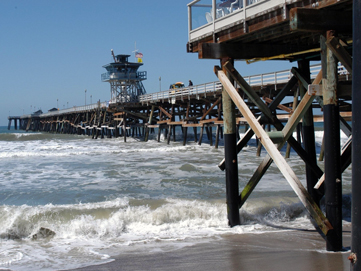
San Clemente is a city in Orange County, California. As of 2010, the city population was 68,763. Located On the California Coast, midway between Los Angeles and San Diego at the southern tip of the county, it is known for its ocean, hill, and mountain views, a pleasant climate and its Spanish Colonial style architecture. San Clemente’s city slogan is “Spanish Village by the Sea”. The official City flower is the Bougainvillea and the official City tree is the Coral tree.
Prior to the arrival of the Spanish, the area was inhabited by what came to be known as the Juaneño Indians. Long admired by explorers and passing settlers, it remained virtually uninhabited until 1776, when Mission San Juan Capistrano was established by Father Junipero Serra and led both Indian and Spanish settlers to set up villages nearby. After the founding of Mission San Juan Capistrano, the local natives were conscripted to work for the mission.
Property rights to the land exchanged hands several times, but few ventured to build on it until 1925, when former Mayor of Seattle, Ole Hanson, with the financial help of a syndicate headed by Hamilton Cotton, purchased and designed a 2,000-acre (8.1 km2) community. Hanson believed that the area’s pleasant climate, beautiful beaches and fertile soil would serve as a haven to Californians who were tired of “the big city”. He named the city after San Clemente Island, which in turn was named by the explorer Vizcaino in 1602 after Saint Clement, whose feast day occurs on November 23, the day of Vizcaino’s arrival on the island.
Hanson envisioned it as a Spanish-style coastal resort town, a “Spanish Village” (“By the Sea” was added years later.) In an unprecedented move, he had a clause added to the deeds requiring all building plans to be submitted to an architectural review board in an effort to ensure that future development would retain some Spanish-style influence (for example, for many years it was required that all new buildings in the downtown area have red tile roofs).
Hanson succeeded in promoting the new area and selling property to interested buyers. The city was to consist of buildings built in the classic Spanish style with red tile roofs. He built public structures such as the Beach Club, the Community Center, the pier and San Clemente Plaza, now known as Max Berg Plaza Park, which were later donated to the city. The area was officially incorporated as a City on February 27, 1928 with a council-manager government.
Referring to the way he would develop the city, Hanson proclaimed, “I have a clean canvas and I am determined to paint a clean picture. Think of it – a canvas five miles long and one and one-half miles wide!”
Largest Historic Landmark in San Clemente: Soon after San Clemente ( The Spanish Village) was incorporated, the need for a “Fire House” was realized. The headlines in San Clemente’s first newspaper, “El Heraldo de San Clemente” June, 1928 read: “Building to house local fire department will be constructed by popular subscription and turned over to the city when completed!” Individual subscriptions were received in the amounts from $6.00 to $1500.00 from the local citizenry.
In 1969, an event occurred which accelerated the growth and reputation of San Clemente. In that year President Richard Nixon purchased a Spanish mansion in the southern part of town that Hamilton Cotton had built in 1927. This “Western White House” became the site of numerous historical meetings. The Old City Plaza also at one time had a small Nixon museum inside when the city occupied the premises.
In 1968 President Richard Nixon bought part of the H. H. Cotton estate, one of the original homes built by one of Hanson’s partners. Nixon called it “La Casa Pacifica”, but it was nicknamed the “Western White House”, a term now commonly used for a President’s vacation home. It sits above one of the West Coast’s premier surfing spots, Trestles, and just north of historic surfing beach San Onofre. During Nixon’s tenure it was visited by many world leaders, including Soviet Premier Leonid Brezhnev, Mexican President Gustavo Díaz Ordaz, Prime Minister of Japan Eisaku Sato, and Henry Kissinger, as well as businessman Bebe Rebozo. Following his resignation, Nixon retired to San Clemente to write his memoirs. He sold the home in 1980 and moved to New York City, later to Saddle River, New Jersey, and then eventually to Park Ridge, New Jersey. The property also has historical ties to the Democratic side of the aisle; prior to Nixon’s tenure at the estate, H.H. Cotton was known to host Franklin D. Roosevelt, who would visit to play cards in a small outbuilding overlooking the Pacific Ocean
A view of Santa Catalina Island, California from San Clemente. The city is known for its mild weather and mediterranean climate
San Clemente is located at ![]() 33°26′16″N 117°37′13″W / 33.43778°N 117.62028°W / 33.43778; -117.62028 (33.437828, -117.620397).[1]
33°26′16″N 117°37′13″W / 33.43778°N 117.62028°W / 33.43778; -117.62028 (33.437828, -117.620397).[1]
According to the United States Census Bureau, the city has a total area of 18.4 square miles (47.6 km²). 17.6 square miles (45.6 km²) of it is land and 0.7 square miles (1.9 km²) of it (4.03%) is water.
San Clemente enjoys a mild climate where temperatures tend to average around the 70′s. The warmest month of the year is August with an average temperature of 79 degrees Fahrenheit. The coldest month is December with an average temperature of 64 degrees Fahrenheit. The annual rainfall in 2010 was 10.5 inches and the annual days of sunshine was 310.